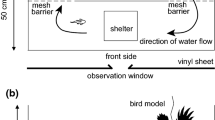Summary
Following exposure to a predator, socially dominant individuals may reduce their risk of predation by waiting until subordinates have resumed foraging before doing so themselves. Although such status-related ordering in the resumption of foraging activity has been observed in several bird species, the underlying mechanism(s) facilitating such a delay remains unknown. Social status per se and status-related foraging benefits prior to a threat of predation (i.e., individual hunger level) have both been suggested as possible mechanisms. We tested between these two alternative suggestions using pairs of stream-dwelling juvenile Atlantic salmon, for which the dominant-subordinate relationship was known. Fish were tested at equal and unequal hunger levels. Fish were presented with drifting prey, followed by a predation threat in the form of an aerial predator model. Which fish (i.e., dominant or subordinate) initially resumed foraging activity after exposure to the predator model was recorded. When both fish were at an equal hunger level, the dominant fish was more likely to resume foraging first. When the dominant and subordinate fish differed in their hunger level, the hungrier fish was the first to resume foraging regardless of social status. These results support the conclusion that hunger level, rather than social status per se, determines the order in which juvenile Atlantic salmon resume foraging after exposure to a predator.
Similar content being viewed by others
References
Abbott JC, Dill LM (1989) The relative growth of dominant and subordinate juvenile steelhead trout (Salmo gairdneri) fed equal rations. Behaviour 108:104–113
Baker MC, Belcher CS, Deutsch LC, Sherman GL, Thompson DB (1981) Foraging success in junco flocks and the effects of social hierarchy. Anim Behav 29:137–142
Convey P (1988) Competition for perches between larval damselflies: the influence of perch use on feeding efficiency, growth rate and predator avoidance. Freshwater Biol 19:15–28
Cunjak RA, Green JM (1984) Species dominance by brook trout and rainbow trout in a simulated stream environment. Trans Am Fish Soc 113:737–743
Desrochers A (1989) Sex, dominance, and microhabitat use in wintering black-capped chickadees: a field study. Ecology 70:636–645
Dill LM, Fraser AHG (1984) Risk of predation and the feeding behavior of juvenile coho salmon (Oncorhynchus kisutch). Behav Ecol Sociobiol 16:65–71
Ekman J (1987) Exposure and time use in willow tit flocks: the cost of subordination. Anim Behav 35:445–452
Ekman JB, Askenmo EH (1984) Social rank and habitat use in willow tit groups. Anim Behav 32:508–514
Fausch KD (1984) Profitable stream positions for salmonids: relating specific growth rate to net energy gain. Can J Zool 62:441–451
Godin J-GJ, Sproul CD (1988) Risk taking in parasitized sticklebacks under threat of predation: effects of energetic need and food availability. Can J Zool 66:2360–2367
Gotceitas V, Colgan P (1988) Individual variation in learning by foraging juvenile bluegill sunfish (Lepomis macrochirus). J Comp Psychol 102:294–299
Grant JWA, Noakes DLG (1987) Escape behaviour and use of cover by young-of-the-year brook trout, Salvelinus fontinalis. Can J Fish Aquat Sci 44:1390–1396
Hegner RE (1985) Dominance and anti-predator behaviour in blue tits (Parus caeruleus). Anim Behav 33:762–768
Hodapp A, Frey D (1982) Optimal foraging by firemouth cichlids, Cichlasoma meeki, in a social context. Anim Behav 30:983–989
Hogstad O (1988) Social rank and antipredator behaviour of willow tits Parus montanus in winter flocks. Anim Behav 130:45–56
Huntingford FA, Metcalfe NB, Thorpe JE (1988) Feeding motivation and response to predation risk Atlantic salmon parr adopting different life history strategies. J Fish Biol 32:777–782
Jenkins TM (1969) Social structure, position choice and microdistribution of two trout species (Salmo trutta and Salmo gairdneri) resident in mountain streams. Anim Behav Monogr 2:57–123
Keenleyside MHA, Yamamoto FT (1962) Territorial behaviour of juvenile Atlantic salmon (Salmo salar L.). Behaviour 19:139–169
Krebs JR, Davies NB (1984) Behavioural ecology: an evolutionary approach, 2nd edn. Sinauer, Sunderland, MA
Krebs JR, MacRoberts MH, Cullen JM (1972) Flocking and feeding in the great tit Parus major: an experimental study. Ibis 114:507–530
Laet JF de (1985) Dominance and anti-predator behaviour of great tits Parus major: a field study. Ibis 127:372–377
Metcalfe NB (1986) Intraspecific variation in competitive ability and food intake in salmonids: consequences for energy budgets and growth rates. J Fish Biol 28:525–531
Metcalfe NB, Huntingford FA, Thorpe JE (1987) The influence of predation risk on the feeding motivation and foraging strategy of juvenile Atlantic salmon. Anim Behav 35:901–911
Morantz DL, Sweeney CS, Shirvell CS, Longard DA (1987) Selection of microhabitat in summer by juvenile Atlantic salmon (Salmo salar). Can J Fish Aquat Sci 44:120–129
Peters WmD, Grubb TC (1983) An experimental analysis of sex-specific foraging in the downy woodpecker, Picoides pubescens. Ecology 64:1437–1443
Powell GVN (1974) Experimental analysis of the social value of flocking in starlings (Sturnus vulgaris) in relation to predation and foraging. Anim Behav 22:501–505
Stamps JA (1984) Rand-dependent compromises between growth and predator protection in lizard dominance hierarchies. Anim Behav 32:1101–1107
Suboski MD, Templeton JJ (1989) Life skills training for hatchery fish: social learning and survival. Fish Res 7:343–352
Waite TA (1987) Dominance-specific vigilance in the tufted titmouse: effects of social context. Condor 89:932–935
Waite TA, Grubb TC (1987) Dominance, foraging and predation risk in the tufted titmouse. Condor 89:936–940
Ware DM (1971) Predation by rainbow trout (Salmo gairdneri): the effect of experience. J Fish Res Board Can 28:1847–1852
White HC (1937) Local feeding of kingfishers and mergansers. J Biol Board Can 3:323–338
White HC (1938) The feeding of kingfishers: food of nestlings and effect of water height. J Fish Res Board Can 4:48–52
Author information
Authors and Affiliations
Additional information
Offprint requests to: V. Gotceitas at the present address
Rights and permissions
About this article
Cite this article
Gotceitas, V., Godin, JG.J. Foraging under the risk of predation in juvenile Atlantic salmon (Salmo salar L.) : effects of social status and hunger. Behav Ecol Sociobiol 29, 255–261 (1991). https://doi.org/10.1007/BF00163982
Received:
Accepted:
Issue Date:
DOI: https://doi.org/10.1007/BF00163982




